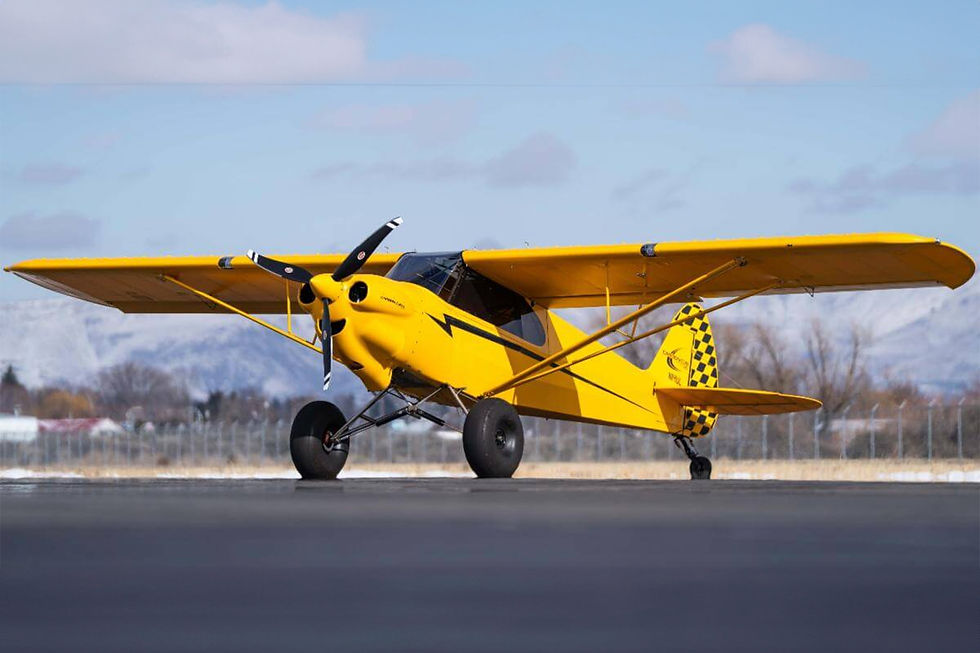Carbon Cub UL Breaks Records Reaching 37609 Feet Altitude
- Garth Calitz
- Nov 4
- 4 min read

The spirit of adventure and innovation that has long defined American backcountry aviation reached new heights, literally, when a factory-stock CubCrafters Carbon Cub UL climbed to a verified altitude of 37,609 feet above sea level. The flight, conducted on October 28, 2025, shattered expectations and set an unofficial world altitude record for Cub-type aircraft, eclipsing a benchmark that had stood for nearly three-quarters of a century.

Piloted by Jon Kotwicki of Fly8MA Flight Training, the lightweight Carbon Cub UL commenced its ascent from San Luis Obispo County Regional Airport (KSBP) under clear skies and calm conditions. Sixty-two minutes later, the compact bush plane reached the upper levels of the troposphere, cruising at the altitudes typically occupied by airliners, in temperatures reaching a frigid –46 °C.

This performance represents a significant advancement beyond the long-standing record of 30,203 feet set in 1951 by pioneering aviator Caro Bayley, who achieved that altitude in a Piper Super Cub over Miami, Florida. Bayley's accomplishment brought her international recognition from the Fédération Aéronautique Internationale (FAI) and the esteemed Blériot Medal. Her record stood for 74 years until this new generation of Cub soared through the clouds and into history.

The record-setting flight was not merely a publicity stunt; it served as a technical showcase of the capabilities of modern ultralight backcountry aircraft when innovative design is combined with pilot expertise and precise engineering. The Carbon Cub UL represents the newest development in CubCrafters’ advancement of the iconic Piper Cub line, capturing founder Jim Richmond’s vision of reinventing the perfect backcountry aircraft using advanced materials, lightweight composites, and contemporary engines.


“This achievement exemplifies everything we stand for, innovation, craftsmanship, and the courage to push limits,” said Brad Damm, Vice President of CubCrafters. “Jim Richmond’s dream was to take the beloved Super Cub and make it better. I think Jim would be the first to congratulate our team on what was achieved with this flight.”
Central to the record attempt was the Rotax 916 iS, a turbocharged engine delivering 160 horsepower, created through a partnership between Rotax and CubCrafters. This engine's performance and efficiency enabled the Carbon Cub UL to keep ascending well beyond the point where most aircraft in its class would have stalled in the thin air. Despite not being an official FAI record attempt, the UL’s performance also surpassed the current official FAI Ultralight altitude record of 35,062 feet, set in 1996 by a Rutan Long EZ.

With flight oversight and coordination from Los Angeles ARTCC, Kotwicki took off from San Luis Obispo at 9:55 a.m., ascending steadily as the air became thinner and colder. Using supplemental oxygen provided by Mountain High Equipment & Supply and donning a parachute for safety, Kotwicki navigated the Cub through conditions seldom encountered by piston aircraft.

“The Cub flew really easily,” he recalled. “We were operating way outside the normal flight envelope, so every step was cautious and deliberate. But to be sitting in a tube-and-fabric bush plane at 37,000 feet, hearing airline pilots on ATC wonder what a Cub was doing up there, that was pretty surreal.”
The aircraft maintained solid control throughout, even with large 29-inch Alaska Bushwheels and camera gear onboard. The original goal had been to surpass Bayley’s 1951 mark of 30,200 feet, but as the UL kept climbing, Kotwicki decided to keep pushing until it reached its ultimate ceiling.

“When the climb rate started dropping, we knew we were at the limit,” he said. “We didn’t expect to hit 37,600 feet, that was a surprise. What amazed us most was that this same aircraft could land on a dirt strip minutes later. That’s the magic of the Carbon Cub UL, it’s a backcountry machine that just proved it can also touch the edge of the stratosphere.”
The project was led by Professor Paulo Iscold, a renowned aerospace engineer from Cal Poly San Luis Obispo, known for his history of experimental flight records. Iscold managed the flight test campaign, ensuring safety, compliance, and precise data collection. “This is my 17th aviation record,” said Iscold. “And it was one of the most enjoyable. The entire team, from CubCrafters and Rotax to Aerocrafted and Mountain High, worked seamlessly together. In flight testing, you prepare for everything to go wrong. But when everything goes right, that’s the flight you want, and that’s exactly what we got.”
Supporting the mission were Aerocrafted’s Tres Clements, who provided hangar space, tools, and ground logistics, and Patrick McLaughlin of Mountain High, who designed a custom oxygen delivery system for the high-altitude challenge.

For CubCrafters, this record is more than a headline, it’s a demonstration of what’s possible when legacy design meets modern innovation. Founded in 1980 in Yakima, Washington, CubCrafters has continually redefined backcountry aviation, offering certified, experimental, and light-sport aircraft that combine rugged capability with refined performance.
































Comments